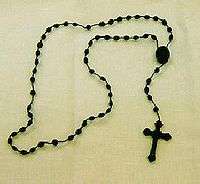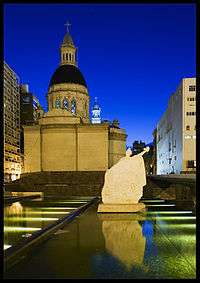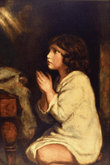History of the Rosary
| Part of a series on the |
| Rosary of the Catholic Church |
|---|
 A Catholic rosary. |
| Overview |
| Prayers and promises |
| Writings |
| People and societies |
|
|
There are differing views on the history of the Rosary. The exact origin of the Rosary as a prayer is less than clear and subject to debate among scholars.
Prayer beads may have their origins in the Eastern religions in India in the 3rd century BC. The use of knotted prayer ropes in Christianity goes back to the Desert Fathers in the 3rd and early 4th centuries. These counting devices were used for prayers such as the Jesus prayer in Christian monasticism. The period after the First Council of Ephesus in 431 witnessed a gradual growth in the use of Marian prayers during the Middle Ages.
According to some Catholic traditions, the Rosary was given to Saint Dominic in a vision of the Blessed Virgin Mary and it was then promoted by Alanus de Rupe. However, not all Catholics agree with that tradition. Some historians see a more gradual development for the Rosary, in that the repetition of Marian prayers which form the basis of the Rosary needed counting devices, which resulted in the modern form of the Rosary prayed on beads.
The practice of meditation during the praying of the Hail Marys was attributed to Dominic of Prussia, a 15th Carthusian monk, who called it "Life of Jesus Rosary" (vita Christi Rosary). However, in 1977, a theologian from Trier named Andreas Heinz discovered a vita Christi Rosary that dated to 1300, suggesting the origin of the current rosary extends back at least to that time.[1] The Christian victory at the Battle of Lepanto in 1571 was attributed to the praying of the Rosary by masses of Europeans based on the request of Pope Pius V and eventually resulted in the Feast of Our Lady of the Rosary. In 1569, the papal bull Consueverunt Romani Pontifices established the devotion to the rosary in the Catholic Church. In 2002 Pope John Paul II introduced the Luminous Mysteries as an option in an Apostolic Letter on the Rosary, Rosarium Virginis Mariae.
History
There are differing views on the history of the rosary. The exact origin of the Rosary as a prayer is less than clear and subject to debate among scholars.[2]
Prayers with beads like the rosary may have begun as a practice by the laity to imitate the Christian monasticism of the Liturgy of the Hours, during the course of which the monks prayed the 150 Psalms daily.[3] As many of the laity and even lay monastics could not read, they substituted 150 repetitions of the Our Father (Pater noster in Latin) for the Psalms, sometimes using a cord with knots on it to keep an accurate count.[2]
According to tradition, the rosary was given to Saint Dominic in an apparition by the Blessed Virgin Mary in the year 1214 in the church of Prouille.[3] This Marian apparition received the title of Our Lady of the Rosary.[4] In the 15th century Blessed Alanus de Rupe (aka Alain de la Roche or Saint Alan of the Rock), who was a learned Dominican priest and theologian, is said to have received a vision from Jesus about the urgency of reinstating the rosary as a form of prayer. Blessed Alanus de Rupe also received the Blessed Mother's "15 Promises". Before his death on September 8, 1475 he reinstituted the rosary in many countries and established many rosary confraternities. Despite the popularity of Blessed Alanus's story about the origins of the rosary, there has never been found any historical evidence positively linking St. Dominic to the rosary. The story of St. Dominic's devotion to the rosary and supposed apparition of Our Lady of the Rosary does not appear in any documents of the Church or Dominican Order prior to the writings of Blessed Alanus.[2] St. Dominic and Blessed Alanus are separated by 300 years..
Historical development

During the middle ages, evidence suggests that both the Our Father and the Hail Mary were recited with prayer beads.[3] In 13th century Paris, four trade guilds existed of prayer bead makers, who were referred to as paternosterers, and the beads were referred to as paternosters, suggesting a continued link between the Our Father (Pater noster in Latin) and the prayer beads.[2]
In the 12th century, the rule of the English anchorites, the Ancrene Wisse, specified how groups of 50 Hail Marys were to be broken into five decades of ten Hail Marys each. Gradually, the Hail Mary came to replace the Our Father as the prayer most associated with beads. Eventually, each decade came to be preceded by an Our Father, which further mirrored the structure of the monastic Divine Office.[2]
The practice of meditation during the praying of the Hail Marys is attributed to Dominic of Prussia (1382–1460), a Carthusian monk, who called it "Life of Jesus Rosary".[5] The German monk from Trier added a sentence to each of the 50 Hail Marys already popular at his time, using quotes from scriptures. Promoted by his superior Adolf von Essen and others, his practice became popular among Benedictines and Carthusians from Trier to adjoining Belgium and France, where it was greatly promoted by the preaching of the Dominican priest Alan de Rupe, who helped to spread the devotion in France, Flanders, and the Netherlands between 1460 and his death in 1475.[6]
In 1475 James Sprenger formed one of the first rosary confraternities in Cologne.[7][8] Rosary confraternities in Venice and Florence were formed in 1480 and 1481.[9]
In the 16th century, Rosary confraternities for women spread in France and Italy, partly because women were excluded from most other societies and because this type did not involve common masses or processions, only private prayer.[10] In 1571 Pope Pius V called for all of Europe to pray the rosary for victory at the Battle of Lepanto, in which the Christian belligerents included the Papal States. The Christian victory at Lepanto was at first celebrated as the feast of "Our Lady of Victory" on October 7, but was later renamed the Feast of Our Lady of the Rosary.[11][12][13]
Official devotion

In 1569, the papal bull Consueverunt Romani Pontifices by the Dominican Pope Pius V officially established the devotion to the rosary in the Catholic Church.[14] Saint Peter Canisius, a Doctor of the Church, who is credited with adding to the Hail Mary the sentence "Holy Mary, Mother of God, pray for us sinners", was an ardent advocate of the rosary and promoted it (and its Marian devotion in general) as the best way to repair the damage done to the Church by the Reformation.[15]
From the 16th to the early 20th century, the structure of the rosary remained essentially unchanged.[2] There were 15 mysteries, one for each of the 15 decades. In the 20th century the addition of the Fatima Prayer to the end of each decade became popular. After Vatican Council II, Msgr. Annibale Bugnini, architect of the liturgical reform, proposed further changes to the structure of the Rosary, but Pope Paul VI refused to implement the proposal on the grounds that changing such a well-established and popular devotion would unsettle the piety of the faithful and show a lack of reverence for an ancient practice. There were thus no other changes until 2002 when John Paul II instituted five new Luminous Mysteries.[16] In the 17th century, the Rosary began to appear as an element in key pieces of Roman Catholic Marian art. Key examples include Murrillo's Madonna with the Rosary at the Museo del Prado in Spain, and the statue of Madonna with Rosary at the church of San Nazaro Maggiore in Milan. Several Roman Catholic Marian churches around the world have also been named after the rosary, e.g. Our Lady of the Rosary Basilica, in Rosario Argentina, the Rosary Basilica in Lourdes and Nossa Senhora do Rosário in Porto Alegre, Brazil.
Key dates
The table shows key dates in the development of the rosary.:[3]
- 4th century prayer rope used by the Desert Fathers to count repetitions of the Jesus Prayer
- By the 7th century prayers to Mary were becoming more common.[17]
- c. 1075 Lady Godiva refers in her will to "the circlet of precious stones which she had threaded on a cord in order that by fingering them one after another she might count her prayers exactly" (Malmesbury, "Gesta Pont.", Rolls Series 311)[2]
- A rule for anchorites in mid-12th century England gives directions on how 50 Hail Marys are to be said divided into sets of ten, with prostrations and other marks of reverence.[2]

- It is recorded by a contemporary biographer that St. Aibert, who died in 1140, recited 150 Hail Marys daily, 100 with genuflexions and 50 with prostrations.[18]
- 1214 traditional date of Saint Dominic's reception of the rosary from the Virgin Mary as Our Lady of the Rosary[3]
- It is recorded of St. Louis of France (1214–70) that "without counting his other prayers the holy King knelt down every evening 50 times and each time he stood upright then knelt again and repeated slowly an Ave Maria." [18]
- 1268 A reference to guild of "paternosterers" in Paris in "Livre des métiers" of Stephen Boyleau.[2]
- Early 15th century, Dominic of Prussia, a Carthusian, introduces 50 mysteries, one for each Ave Maria[19]
- 15th century blessed Alanus de Rupe (Alain de la Roche) established the "15 rosary promises" and started many rosary confraternities
- c. 1514 Hail Mary prayer attains its current form.[18]
- 1569 Pope Pius V established the current form of the original 15 mysteries[20]
- 1579 Instructions and advertisements, how to meditate the misteries of the rosarie of the most holy Virgin Mary by Gaspar Loarte is published [21]
- 1587 Rosario della Sacratissima Vergine Maria by Ven. Luis de Granada is published.
- 1589 Instructions for the use of the beades by John Bucke is published.[22]
- 1597 first recorded use of the term "rosary" to refer to prayer beads.[23]
- 1917 Our Lady of Fatima is said to ask that the Fatima Prayer be added to the Rosary. Her visionaries state that she also asks for the Rosary to be said to stop the war.
- 1974 Pope Paul VI issues the Apostolic Letter Marialis Cultus which devotes 14 sections to the use of the rosary within the Roman Catholic Church.[24]
- 2002 Pope John Paul II introduces the Luminous Mysteries as an option for Roman Catholics in an Apostolic Letter on the Rosary, Rosarium Virginis Mariae.[25]
Ropes, beads and prayers
The use of ornamental beads dates to 10,000 BC.[26] The English word bead derives from the Old English noun bede which means a prayer.[27][28][29][30] The earliest use of prayer beads probably traces to Hindu prayers in India in the 3rd century BC, then to Buddhism.[26][28][31] There are no prayer beads in Judaism.[28]
The earliest Christian devices for counting prayers trace to the Desert Fathers who started Christian monasticism in the 3rd century.[28][31] They had the habit of praying 150 psalms a day and in order to keep track of the count kept 150 pebbles in a bowl or a bag, and removed a pebble after each psalm.[31] St. Anthony of Egypt and St. Pachomius are often associated with the development of prayer ropes in the 4th century.[31][32] These were ropes with 150 knots and gained popularity because they weighed less than a bag of 150 pebbles.[31] These prayer ropes (also called komboskini) continue to be used in Eastern Christianity today.[31] These ropes were only used for prayers such as the Jesus Prayer and the Lord's Prayer and involved no prayers to the Virgin Mary.[31][32]
The earliest known prayer to Mary is the Sub tuum praesidium, which begins with the words: "Beneath your compassion, we take refuge."[33][34] The earliest text of Sub tuum praesidium traces to the Coptic Orthodox liturgy and a copy written in Greek dates to around the year 250.[35] After the First Council of Ephesus in 431 the title Theotokos and the veneration of Mary as the "Mother of God" were established and a period of growth for Marian prayers started.[36][37]
An Egyptian Coptic ostracon that dates to around the year 600 bears the Greek words: "Hail Mary full of grace, the Lord is with thee; blessed art thou amongst women and blessed is the fruit of thy womb, because thou didst conceive Christ, the Son of God, the Redeemer of our souls". This Eastern variant of the Ave Maria was apparently intended for liturgical use, just as the earliest form of the Hail Mary in the Western Church took the shape of an antiphon.[17] However, there is little or no trace of the Hail Mary as an accepted "devotional formula" before about 1050.[38] While two Anglo-Saxon manuscripts at the British Museum, one of which may be as old as the year 1030, show the words "Ave Maria" etc. and "benedicta tu in mulieribus et benedictus fructus ventris tui" it is not certain when these clauses were first joined to make one prayer[38] The way that the rosary works is that your pray multiple of smaller prayers that became one huge prayer to worship and honor Jesus, Mary, and God.
See also
- Catholic devotions
- Christian meditation
- Our Lady of the Rosary
- Prayer, meditation and contemplation in Christianity
- Rosary
- Rosary and scapular
- Rosary devotions and spirituality
References
- ↑ [Anne Winston-Allen. Stories of the Rose (University Park, PA: Pennsylvania State University Press, 1997), 7]
- 1 2 3 4 5 6 7 8 9 Thurston, Herbert, and Andrew Shipman. "The Rosary." The Catholic Encyclopedia. Vol. 13. New York: Robert Appleton Company, 1912. 30 April 2014
- 1 2 3 4 5 Miller, John D., Beads and Prayers: The Rosary in History and Devotion, 2002 ISBN 0-86012-320-0 pages 7-15
- ↑ Catherine Beebe, St. Dominic and the Rosary ISBN 0-89870-518-5
- ↑ A Heinz, Rosenkranz, Marienlexikon, Eos, St.Ottilien, 1993, 555
- ↑ McNicholas, John. "Alanus de Rupe." The Catholic Encyclopedia. Vol. 1. New York: Robert Appleton Company, 1907. 30 April 2014
- ↑ Falhbusch, Erwin and Bromiley, Geoffrey William. The encyclopedia of Christianity, Volume 4, 2005 ISBN 0-8028-2416-1 p. 756
- ↑ Candelaria, Lorenzo. The Rosary Cantoral: Ritual and Social Design, 2008 ISBN 1-58046-205-7 pp. 70-72
- ↑ Winston-Allen, Anne. Stories of the rose: the making of the rosary in the Middle Ages, 1997 ISBN 0-271-01631-0 p. 69
- ↑ Black, Christopher F., Italian Confraternities in the Sixteenth Century, 2003 ISBN 0-521-53113-6 p. 103
- ↑ Butler, Alban. Butler's Lives Of The Saints (April), (1999) ISBN 0-86012-253-0 page 222
- ↑ "Battle of Lepanto (1571)", EWTN
- ↑ Chesterton, Gilbert. Lepanto, 2004, Ignatius Press ISBN 1-58617-030-9
- ↑ Scaperlanda, Maria Ruiz. The Seeker's Guide to Mary, 2002, ISBN 0-8294-1489-4 p. 151
- ↑ Finley, Mitch. The Seeker's Guide to Saints, 2000, ISBN 0-8294-1350-2 p. 73
- ↑ APOSTOLIC LETTER ROSARIUM VIRGINIS MARIAE OF THE SUPREME PONTIFF JOHN PAUL II TO THE BISHOPS, CLERGY AND FAITHFUL ON THE MOST HOLY ROSARY (Dated Oct. 16, 2002)
- 1 2 Thurston, Herbert. "Devotion to the Blessed Virgin Mary." The Catholic Encyclopedia. Vol. 15. New York: Robert Appleton Company, 1912. 30 April 2014
- 1 2 3 Thurston, Herbert. "Hail Mary." The Catholic Encyclopedia. Vol. 7. New York: Robert Appleton Company, 1910. 30 April 2014
- ↑ Mougel, Ambrose. "Dominic of Prussia." The Catholic Encyclopedia. Vol. 5. New York: Robert Appleton Company, 1909. 30 April 2014
- ↑ "CONSUEVERUNT ROMANI Pope Pius V". Retrieved 2007-02-10.
- ↑ Google books
- ↑ Bucke, John. Gallica Online Library Transcribed into Modern English
- ↑ "Online Etymology Dictionary - Rosary". Retrieved 2007-02-10.
- ↑ Pope Paul VI. "Marialis Cultus"
- ↑ "Apostolic Letter Rosarium Virginis Mariae". Retrieved 2007-02-10.
- 1 2 Beads and bead makers: gender, material culture, and meaning by Lidia D. Sciama, Joanne Bubolz Eicher 19988 ISBN 1-85973-995-4 page 1
- ↑ The concise dictionary of English etymology by Walter W. Skeat 1988 ISBN 1-85326-311-7 page 38
- 1 2 3 4 Bead One, Pray Too by Kimberly Winston 2008 ISBN 0-8192-2276-3 pages 4-10
- ↑ Beads and bead makers: gender, material culture, and meaning by Lidia D. Sciama, Joanne Bubolz Eicher 19988 ISBN 1-85973-995-4 page 76
- ↑ Your Faith, Your Life: An Invitation to the Episcopal Church by Jenifer Gamber, Bill Lewellis 2009 ISBN 0-8192-2321-2 pages 134-136
- 1 2 3 4 5 6 7 Linking Your Beads: The Rosary's History, Mysteries, and Prayers by Patricia Ann Kasten 2011 ISBN 1-59276-929-2 OSV Publishers pages 11-13
- 1 2 The Jesus Prayer by Frederica Mathewes-Green 2009 ISBN 1-55725-659-4 page 62
- ↑ Burke, Raymond L.; et al. (2008). Mariology: A Guide for Priests, Deacons, Seminarians, and Consecrated Persons ISBN 978-1-57918-355-4 page 178
- ↑ Mary for evangelicals by Tim S. Perry, William J. Abraham 2006 ISBN 0-8308-2569-X page 142
- ↑ Matthewes-Green, Frederica (2007). The Lost Gospel of Mary: The Mother of Jesus in Three Ancient Texts. Brewster MA: Paraclete Press. pp. 85–87. ISBN 978-1-55725-536-5.
- ↑ Mary in the Christian tradition by Kathleen Coyle 1996 ISBN 0-85244-380-3 pages 49-50
- ↑ The Image of the Virgin Mary in the Akathistos Hymn by Leena Mari Peltomaa 2001 ISBN 90-04-12088-2 pages 76-77
- 1 2 Catholic encyclopedia


